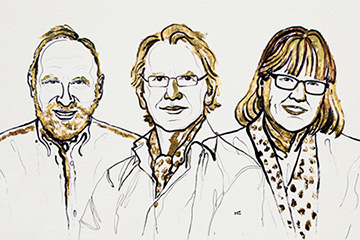
Arthur Ashkin, Gérard Mourou and Donna Strickland, 2018 Nobel Laureates in Physics. [Image: Illustration by Niklas Elmehed, © Nobel Media AB 2018]
The 2018 Nobel Prize in Physics has recognized “groundbreaking inventions in laser physics” during the 1970s and 1980s that set up decades of subsequent scientific advances.
Half of the prize has gone to OSA Honorary Member Arthur Ashkin of Bell Laboratories, USA, for his discovery and advancement of techniques using laser-based optical tweezers to capture, move and measure forces on small objects. The other half is shared by OSA Fellow Gérard Mourou of the École Polytechnique, France, and OSA Fellow and 2013 OSA President Donna Strickland of the University of Waterloo, Canada, for their invention of chirped-pulse amplification (CPA), the technique that has underlain vast advances in the power of ultrafast pulsed lasers since 1985.
The selection of Strickland made her the first female Nobel physics laureate in more than 50 years, and only the third female physics laureate in the prize’s history.
Ashkin: The optical-tweezers revolution
The prize for Ashkin recognizes work that the Nobel Committee characterized as “before its time.”
The general notion that light might exert radiation pressure stretches back centuries—it was cited by Johannes Kepler, for example, as the reason that comets’ tails point away from the sun. But it was not until the advent of the laser in the 1960s that the opportunity arose to put that pressure to practical use.
Ashkin grabbed onto that opportunity in 1970, with a landmark paper in Physical Review Letters in which he demonstrated the use of focused beams from continuous-wave lasers to trap and move small dielectric particles. Then, along with several colleagues at Bell Laboratories (including future Nobel laureate Steven Chu), Ashkin followed up that work with a design, published in Optics Letters in 1986, for a single-beam optical trap that worked by passing laser light through a microscope objective lens. This setup, which came to be called optical tweezers, became a linchpin both in subsequent research involving trapping and cooling atoms, and in work with biological and cell systems.
In papers published in Science and Nature in 1987, Ashkin and several colleagues demonstrated the optical trapping and manipulation of viruses and bacteria. The tool subsequently played a significant role in biophysical investigations of the forces and activity of proteins driving bacterial flagella, as well as of molecular-motor proteins, such as kinesin, that handle the transportation of cargo along microtubules in eukaryotic cells. The emergence of tweezer techniques, the Nobel Committee concluded, “has opened a new window through which we can view the molecular foundations of biology.”
Mourou and Strickland: Beefing up pulse power
The other half of the 2018 Physics prize recognized the work by Mourou and Strickland that enabled the spectacular rise in the power of ultra-short-pulse lasers since 1985.
Before their work, the development of ultra-short-pulse, mode-locked lasers did not come with an accompanying rise in laser power, because efforts to meaningfully boost pulse power led to damage to the amplifiers doing the work. As a result, after the laser’s early development in the early to mid-1960s, laser intensity remained stubbornly capped at levels below 1015 W/cm2.
Mourou and then-grad-student Strickland, at the University of Rochester, USA, hit upon an ingenious solution to the amplification quandary, published in 1985. First, an ultra-short pulse—specifically, a low-energy, nanojoule pulse from a mode-locked Nd:YAG laser—could be stretched out in time a hundred or even a thousand fold, with a corresponding decrease in its peak power. Then, the stretched-out pulse would itself be amplified to a peak level that was within the ability of laser materials to handle. Finally, afterward, the chirped pulse is re-compressed to its original duration. As a result, the integrated energy of the amplified, chirped pulse is packed back into a much shorter duration, boosting the original pulse’s peak power by orders of magnitude.
CPA’s invention kicked off a period of enormous increases in laser power since 1985—setting up the advent of the petawatt-peak-power lasers that are now being ramped up in the European Extreme Light Infrastructure and other projects. The application space of such lasers is indeed vast, ranging from compact laser-wakefield particle accelerators, to medical applications, to studies of the ultrafast dynamics of electrons and atoms (via subsequent techniques for creating attosecond pulses that were aided by CPA-based lasers), to probing the deepest nature of the vacuum itself. Indeed, Mourou himself talked about the opportunities ahead for high-intensity laser science in a plenary address at the September 2018 Frontiers in Optics/Laser Science conference in Washington, D.C. (A video of the talk can be found on the FiO+LS site.)
Breaking the drought of female laureates
Reached on the phone by the Nobel Committee during the press conference announcing the award, Strickland noted that her work with Mourou was part of a general quest by numerous scientists at the time to find ways to compress and amplify pulses. She did admit, however, that “it’s somewhat thinking outside the box to stretch first, and then amplify.”
Strickland was asked about her views on being only the third woman selected to receive a Nobel Prize in Physics, and noted that she had thought there were more than that. “We need to celebrate women physicists, and hopefully in time it will move forward at a faster rate,” she said. In any event, she continued, “I’m honored to be one of those women.”
Olga Botner of Uppsala University, a member of the Nobel Committee, added, in response to a question about the number of female nominees for the award, that “the percentage reflects the percentage of women as they were in previous years … two or three decades back in time.” She suggested that, given the increasing proportion of women in physics since then, their representation in future Nobel physics prize nominations and awards might also increase.
